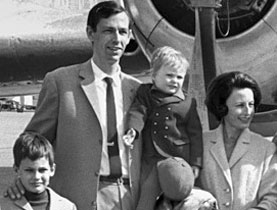Solar Impulse completes first flight

Swiss adventurer Bertrand Piccard’s team has successfully completed its first flight with a prototype for a round-the-world solar effort.
The Solar Impulse plane landed after one-and-a-half hours in the air near its base, a military airfield at Payerne in western Switzerland.
Piccard, who in 1999 co-piloted the first non-stop round-the-globe balloon flight, said the aim of the test flight was to see if the plane, with the wingspan of a Boeing 747 and the weight of a small car, could keep a straight trajectory.
Test pilot Markus Scherdel manned the flight, which wasn’t supposed to surpass 1,000 metres in altitude.
The team plans to fly it around the world in 2013. Originally this was intended for 2012.
It was a “very important moment” after six years of work, said Piccard’s co-pilot Andre Borschberg.
“It went extremely well – we couldn’t have hoped for more,” he told Swiss television.
The takeoff, which began with four propellers lifting the massive craft off the ground at near bicycle speed, and landing both appeared smooth.
The Solar Impulse lifted off at no faster than 45km/h after only a short acceleration on the runway. It slowly gained altitude and disappeared eventually into the horizon as villagers watched from the nearby hills.
The descent was even slower, as the sun-powered craft hovered ahead of the runway for a couple of minutes before touching down to cheers from spectators.
The weather for the maiden flight was sunny.
Scooter in the sky
The €70 million (SFr100 million) project has been conducting flea-hop tests since December, taking the plane no higher than 60 centimetres in altitude and 300 metres in distance. A night flight is planned later this year, and then a new plane will be built based on the results of those tests.
The big takeoff is planned for 2013 and it will use not an ounce of fuel.
Powered by almost 12,000 solar cells, rechargeable lithium batteries and four electric motors, Piccard and co-pilot Andre Borschberg plan to take the plane around the world with stops to allow them to switch over and stretch after long periods in the cramped cockpit.
With the engines providing only 40 horsepower, the plane will fly almost like a scooter in the sky, at an average flight speed of 70km/h.
The trip will be split up into five stages – keeping the plane in the air for up to five days at a time – with the stopovers also allowing the team to show off their creation.
Long line of adventurers
Solar flight isn’t new but Piccard’s project is the most ambitious.
In 1980 the fragile Gossamer Penguin ultra-lightweight experimental solar plane flew short demonstration flights with one pilot on board. A more robust project called the Solar Challenger flew one pilot from France to Britain in more than five hours in 1981.
Solar plane technology recalls the early days of manned flight, and the slow ascent of the Solar Impulse was somewhat reminiscent of the Wright brothers’ pioneering experiments over a century ago.
Piccard himself comes from a long line of adventurers. His late father Jacques plunged deeper beneath the ocean than any other man, and grandfather Auguste was the first to take a balloon into the stratosphere.
swissinfo.ch and agencies
Seven years of work, calculations, simulations and tests were needed by the 70-person team to complete the aircraft.
It has the wingspan of a Boeing 747-400 and the weight of an average family car at 1,600kg.
It has 12,000 solar cells mounted onto the wing, which will supply energy to the four electric motors with a maximum power of 10 HP each.
During the day they will also charge the polymer lithium batteries (400kg), which will allow the aircraft to fly at night.
There have been other attempts at solar-powered flight.
Nasa achieved success in 1997 when its Pathfinder—a lightweight, unmanned, flying wing—built with the AeroVironment firm climbed to 21,793 metres under its own power.
In 2001 the remotely piloted Helios aircraft reached an altitude of 29,524 metres —an unofficial world-record altitude flight for a solar plane. During a 2003 flight, Helios crashed near Hawaii.
The first really notable solar aircraft was AeroVironment’s Solar Challenger, which crossed the English Channel in July 1981.

In compliance with the JTI standards
More: SWI swissinfo.ch certified by the Journalism Trust Initiative




You can find an overview of ongoing debates with our journalists here. Please join us!
If you want to start a conversation about a topic raised in this article or want to report factual errors, email us at english@swissinfo.ch.